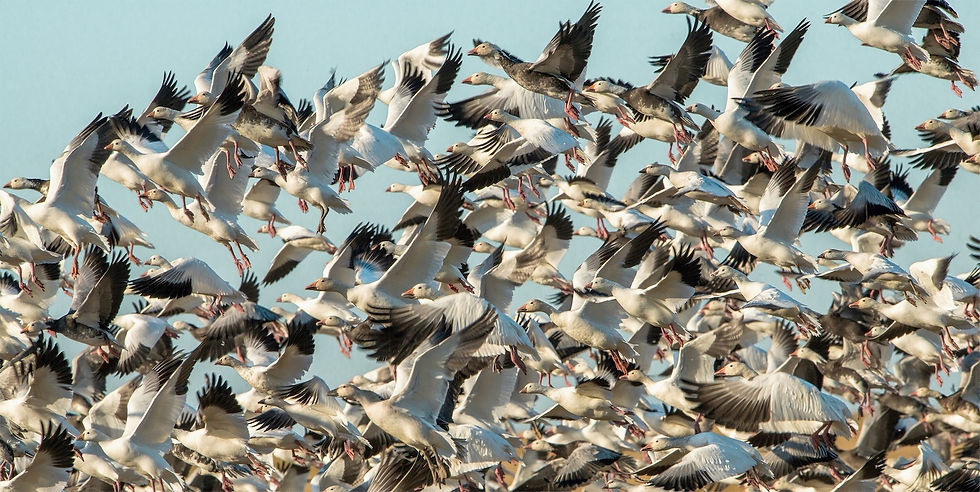Saskatchewan: A birding paradise
- Nele Remstedt

- Nov 29, 2023
- 3 min read
Updated: Nov 30, 2023

Saskatchewan is located on the North American Central Flyway, one of the four major migratory bird routes on the continent. As such, there are enough opportunities for birdwatching that a dedicated birder could spend a summer spotting our feathered friends.
Last Mountain Lake National Wildlife Area
The Last Mountain Lake National Wildlife Area is home to the oldest bird sanctuary in North America. Over 200 species migrate through the area, while others nest here. Facilities on the north end of the lake include self-guided trails, an observation tower and picnic site. The Last Mountain Bird Observatory, run by Nature Saskatchewan, is located in Last Mountain Regional Park and is Saskatchewan's only bird monitoring station.

Quill Lakes International Bird Area
Wynyard and Foam Lake each have facilities that showcase the Quill Lakes International Bird Area, which contains Canada’s largest saline lake and sees more than a million waterfowl, shorebirds and songbirds each year. It is a renowned birdwatching location. The Quill Lakes Interpretive Centre, in Wynyard, provides visitors with information about local nature viewing sites, as well as area history and folklore. The Foam Lake Visitor Centre offers interpretive displays and information about nearby nature and walking trails. The Foam Lake Heritage Marsh has three viewing areas with walking trails and lookout points where visitors can spot wildlife and birds – sandhill cranes, great blue herons, swans, pelicans and more.

Saskatchewan Burrowing Owl Interpretive Centre
The Saskatchewan Burrowing Owl Interpretive Centre in Moose Jaw offers the chance to observe these unique birds up close. On the endangered species list since 1995, burrowing owl numbers continue to diminish. Visitors can walk through the interpretive centre exhibit and view a native prairie garden. The centre also has onsite interpreters.

Redberry Lake Biosphere Region
The Redberry Lake Biosphere Region is one of 19 UNESCO biospheres in Canada, and the only one located in Saskatchewan. The deep, magnesium sulphate lake is a protected Federal Bird Sanctuary. An expansive watershed is a nesting and feeding spot for migratory birds, including endangered whooping cranes. In addition to the saline lake, the environment includes freshwater lakes, natural prairie, ponds, marshes and aspen groves. Nearly 200 bird species have been spotted in the area. The region is a designated Important Bird Area and offers many birdwatching opportunities along its winding trails.

Ravine Ecological Preserve & Yellowhead Flyway Birding Trail
A 2.8-km trail traverses a variety of habitat from aquatic to parkland in the Ravine Ecological Preserve in Yorkton. The 20-acre nature preserve also has a 500-ft. floating boardwalk, gravelled pathways, frog pond and an arboretum with trees native to Saskatchewan that add to the trail’s interest. The preserve is part of the Yellowhead Flyway Birding Trail network, which comprises prairie and valley trails in Yorkton and surrounding area, including the Cherrydale Birding Trail (Yorkton), Kaposvar Birding Trail (Esterhazy), Leflay Birding Trail and Sawkey Bird & Nature Trail (Saltcoats), and Carlton Trail Regional Park Trail (Spy Hill).

Nicolle Flats Interpretive Area
Located on the southeast side of Buffalo Pound Lake, the Nicolle Flats Interpretive Area is home and a stopover area for a great variety of wildlife. Experience the beautiful scenery and the sounds of wildlife, while hiking the winding nature trails that vary in length from 1.5-8 km. In the summer, spot pelicans, blue herons and black-crowned night herons and other species. The marshy wetland is important as a staging area for ducks during fall migration.

Further information can be found at www.tourismsaskatchewan.com.



Comments